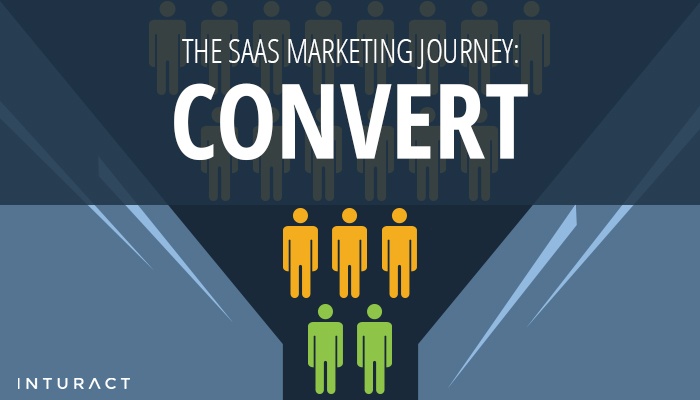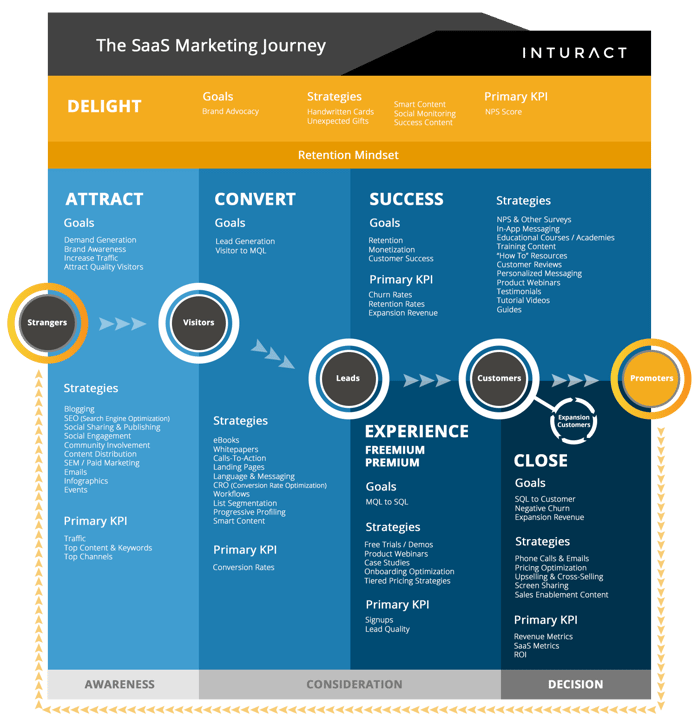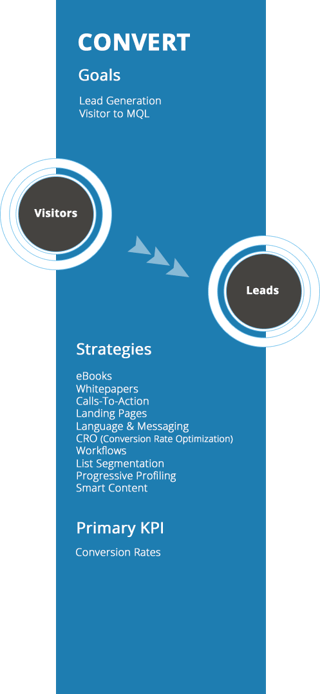
As subscription models rise in popularity, Software as a Service products are fast evolving from the new frontier to the industry forefront. Because of this continual need to win and retain customers, the significance placed on a scalable, customized marketing strategy has never been stronger. While SaaS marketing previously held mostly to the established strategies used by inbound marketing (as illustrated in a popular HubSpot infographic), the changing nature of the industry has demanded the development of an updated methodology.
The SaaS Marketing Journey
Using the inbound marketing model as a foundation, we’ve created an expanded process that more directly applies to SaaS products that businesses can use to guide their product growth. Dubbed the SaaS Marketing Journey, it provides organizations from startups to established players with the guidance they need to successfully market their products.
To get you started, we’ll be bringing a step-by-step breakdown of the SaaS Marketing Journey, giving you invaluable insight into each stage. Throughout the process, you’ll discover how potential customers are transformed into engaged customers who actively promote your products for you. Here’s a quick preview of the complete SaaS Marketing Journey:
See The Complete SaaS Marketing Journey

Share this Image On Your Site
We’ve already delved into the Attract phase -- which centers on creating demand and building awareness among your target audience -- and subsequent entries will outline the rest of the process. However, for now, let’s proceed to the next stage in your customer development: Convert.
Let’s Convert
 Whereas the Attract stage aimed to turn strangers into visitors, this phase looks to convert these newfound visitors into substantive leads. As such, the overriding goal is to guide prospects along the SaaS Marketing Journey, developing their awareness of your product and generating genuine interest in what you have to offer. Of course, the more knowledge you have about your ideal buyer persona the better equipped you will be to attract the kinds of leads you want, and the Convert stage operates under the expectation that you’ve already succeeded in priming your target audience. Now that you have these prospects hooked, the objective is to develop them into the marketing-qualified leads that can help grow your business
Whereas the Attract stage aimed to turn strangers into visitors, this phase looks to convert these newfound visitors into substantive leads. As such, the overriding goal is to guide prospects along the SaaS Marketing Journey, developing their awareness of your product and generating genuine interest in what you have to offer. Of course, the more knowledge you have about your ideal buyer persona the better equipped you will be to attract the kinds of leads you want, and the Convert stage operates under the expectation that you’ve already succeeded in priming your target audience. Now that you have these prospects hooked, the objective is to develop them into the marketing-qualified leads that can help grow your business
To do so, it’s essential to develop the appropriate messaging to push them along on the SaaS Marketing Journey. When it comes to the SaaS model, data is key to understanding the sales stages within your organization and the kind of leads your product needs to cultivate. Only then can a new prospect be led to the next stage of the process. Below we’ll get into some of the strategies you can use to create quality leads to foster your product’s growth.
The Strategies You Can Use
Much like the Attract stage relies heavily on content marketing and social engagement to foster interest in your product, the Convert phase uses similar tools in tandem with other elements to drive prospects forward in the SaaS Marketing Journey. Here’s a rundown of some of the most popular forms of messaging you can use to entice visitors to convert into solid leads:
- eBooks/Whitepapers: Content marketing methods like blogs and social media posts are useful to hook visitors, but once you have their attention, more detailed documents like eBooks and whitepapers can further demonstrate your knowledge of the industry and the distinct benefits that your product offers.
- Calls to Action (CTAs): There’s certainly something to be said for a solid CTA, one of the first touch points in the sales process. In the case of your SaaS product, this could include any number of actions. It could start with TOFU (Top of The Funnel) content with CTA's to informational resource landing pages. Or you could be offering a free trial to new customers, ask them to request a demo or even go the direct route and entice them to sign up for a free or paid plan outright. It is important to not pressure visitors with CTA's. Make sure you implement them within the flow and educational process of your product.
- Conversion Rate Optimization (CRO): Few means of securing leads are as successful as performing vigorous testing and analysis to confirm that your site is optimized for maximum conversion. This might involve everything from tweaking the language in your CTA to developing alternative layouts for your landing page. Test often and continuously progress your results, but remember not to test too many things at once, it can muddy the waters. Also avoid multiple concurrent tests aimed at improving the same metric. Keep it simple at first and just do a couple tests. Get them right and then look into scaling your testing process for greater results.
- Landing Pages: Speaking of landing pages, this is the conversion point, therefore this is an area you should not take lightly and really focus your efforts. Your landing page should highlight key takeaways and still entice your user to forge ahead. A common practice to keep the visitor dialed in is to remove your menu items as you do not want to distract your user to leave the page. Be sure to format your content in a legible and attractive way. You could include some appealing bullet points, testimonials, value stats, and imagery. Be sure to include an optimized form that asks for the right amount of information in correlation with the landing page's offer.
- Workflows: As Laverne is to Shirley, workflows are to your offers. (I love workflows just as much as I love nick-at-nite) You will create these around key factors that your lead does, whether they opened an email, click on a specific link within your email, heck - even if they don't open your email...you can send nudge follow up emails. You can set these up to speak to your lead no matter what path they decide to go down within the process. You can use workflows to begin to engage with them, provide them tips, offers, suggested reads. Once they begin to trickle further down the workflow funnel, you can present them with more specific data, CTA's, free trials and demos. This is yet another platform for you to keep the interest alive and engage with your lead based upon their non verbal actions.
- List Segmentation: Once your lead has provided you with enough data about themselves within their conversion points, you can begin to segment them into specific lists. These lists come in handy when you want to send personalized data to certain people. They are also helpful with aligning marketing and the sales teams and better understanding your lead ratios to persona type. Segmentation is crucial in building out email marketing and smart content (read below) that caters the right types of content to your leads and prospective customers.
- Progressive Profiling: There are many ways to implement progressive profiling, but the idea is to constantly be building out your leads profile further to have more insights on the types of leads your are collecting in relation to their interests. You could do this within your product by creating a "Your Profile is X% complete" and incentivizing your customers to complete their profile. Or, at Inturact, we use smart forms to do this. They come in very handy when you want to begin progressively profiling your contacts before they become a customer. Each time they hit a smart form on your site, it will remember past information they have filled out and will begin to ask them more in-depth questions to begin to build out their profile behind the scenes. This is where you get to know your leads on a deeper level and can really know what it is that they are looking for. Once you begin to effectively develop your contact's profile, you will be able to trigger them into your workflows as a particular persona, add them to your segmented lists, and tailor your content around their specific wants and needs.
- Smart Content: If you are looking to talk to visitors by specifically addressing them with more personalized information, Smart Content is the answer. By creating text that dynamically changes based on what information you know about a visitor you can speak more directly to them. For example, if you have a repeat visitor that has already downloaded a resource from your site, you know a bit more about them and can segment them into a list, then you can start catering your site around their interests. If you run an international site and you know someone is from the United States, maybe you only show text specific to this geographic region. Or maybe you offer three types of products that cater to different industries. If you know someone is interested in a specific product, then you would know that it would benefit them to have content around the correlating industry. This type of technology is not available everywhere, so if you think it could benefit your business then try to take it into consideration when planning your marketing strategy.
While the approaches above are among the most widely used tactics for converting new visitors into engaged leads, we would love to hear about any other approaches you have done in the comments below.
How to Measure Success
Since conversion is the end goal, keeping a close eye on your conversion rates is truly the best indicator of how effective the strategies you’ve put in place truly are in persuading visitors to consider becoming long-term customers. You should be sure to setup a conversion funnel to analyze your drop-off points to better understand the areas that need the most attention.
If your product is not connecting with visitors like you anticipated, it may be time to re-evaluate your conversion strategies and take a closer look at the tools you’ve implemented during the Convert stage.
Diving Deeper
We’re far from done discussing the full SaaS Marketing Journey, but the importance of the Convert stage cannot be underestimated, as it represents a critical transition in turning uninitiated visitors into loyal customers. We look forward to continuing to share this guide and delving in-depth into each step along the way. Stay tuned for more information in the near future, and prepare to revitalize your perspective on best marketing practices for your SaaS business. Up next, Experience.
Be sure to leave comments below and let us know your thoughts, ideas or insights on this stage or any other stage of the SaaS Marketing Journey.


